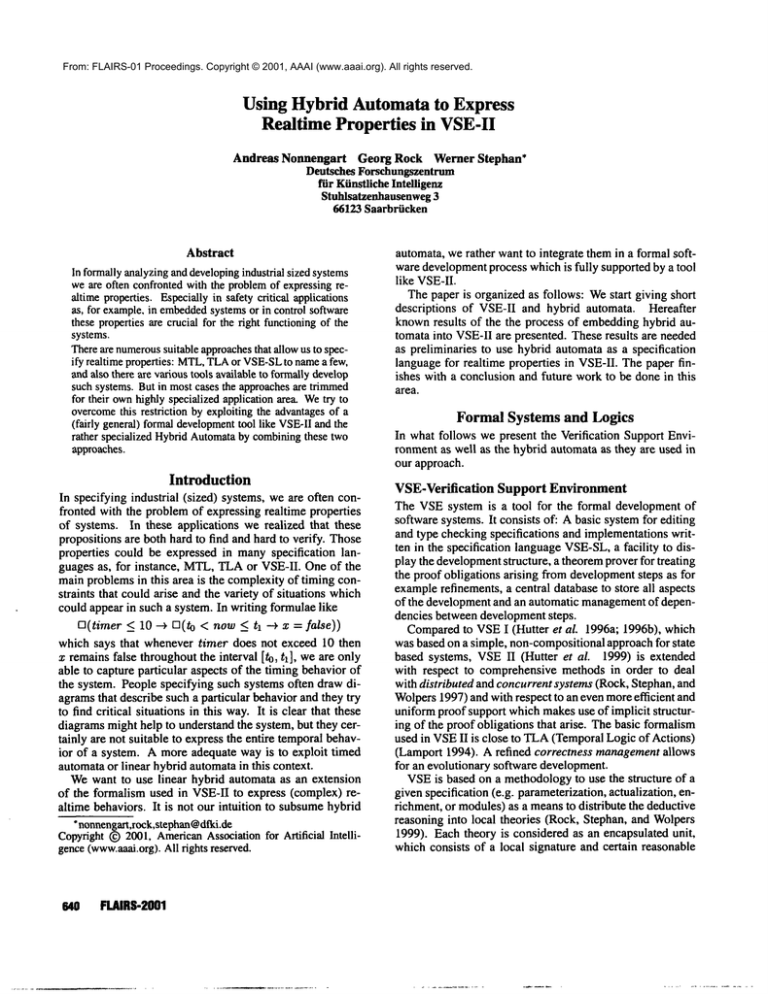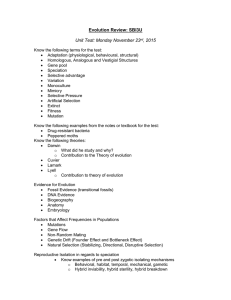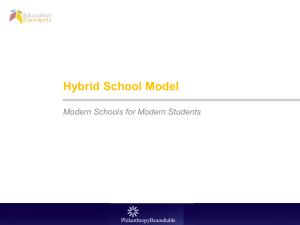
From: FLAIRS-01 Proceedings. Copyright © 2001, AAAI (www.aaai.org). All rights reserved.
Using Hybrid Automata to Express
Realtime Properties in VSE-II
Andreas Nonnengart Georg Rock Werner Stephan*
Deutsches Forschungszentrum
fiir KiinstlicheIntelligenz
Stuhlsatzenhausenweg
3
66123Saarbriicken
Abstract
In formallyanalyzinganddevelopingindustrial sized systems
weare often confrontedwith the problemof expressingrealtime properties. Especiallyin safety critical applications
as, for example,in embedded
systemsor in control software
these propertiesare crucial for the fight functioningof the
systems.
Thereare numerous
suitable approachesthat allowus to specify realtime properties: MTL,TLAor VSE-SL
to namea few,
and also there are varioustools availableto formallydevelop
such systems.But in mostcases the approachesare trimmed
for their ownhighlyspecializedapplicationarea. Wetry to
overcome
this restriction by exploiting the advantagesof a
(fairly general)formaldevelopment
tool like VSEolIand the
rather specialized HybridAutomata
by combiningthese two
approaches.
Introduction
In specifying industrial (sized) systems, we are often confronted with the problemof expressing realtime properties
of systems. In these applications we realized that these
propositions are both hard to find and hard to verify. Those
properties could be expressed in manyspecification languages as, for instance, MTL,TLAor VSE-II. One of the
main problemsin this area is the complexityof timing constraints that could arise and the variety of situations which
could appear in such a system. In writing formulaelike
rq(timer <_ 10 ~ D(to < now < tl --~ x = false))
which says that whenever timer does not exceed 10 then
x remains false throughoutthe interval [to, h], we are only
able to capture particular aspects of the timing behavior of
the system. People specifying such systems often draw diagramsthat describe such a particular behavior and they try
to find critical situations in this way.It is clear that these
diagrams might help to understand the system, but they certainly are not suitable to express the entire temporalbehavior of a system. A more adequate way is to exploit timed
automataor linear hybrid automatain this context.
Wewant to use linear hybrid automata as an extension
of the formalism used in VSE-II to express (complex) realtime behaviors. It is not our intuition to subsumehybrid
*nonnengart,rock,stephan@dfki.de
Copyright(~) 2001, American
Associationfor Artificial Intelligence(www.aaai.org).
All rights reserved.
640
FLAIRS-2001
automata, we rather want to integrate themin a formal software developmentprocess whichis fully supported by a tool
like VSE-II.
The paper is organized as follows: Westart giving short
descriptions of VSE-II and hybrid automata. Hereafter
knownresults of the the process of embeddinghybrid automata into VSE-IIare presented. Theseresults are needed
as preliminaries to use hybrid automata as a specification
language for realtime properties in VSE-II. The paper finishes with a conclusion and future workto be done in this
area.
Formal Systems and Logics
In what follows we present the Verification Support Environmentas well as the hybrid automata as they are used in
our approach.
VSE-Verification Support Environment
The VSEsystem is a tool for the formal development of
software systems. It consists of: A basic systemfor editing
and type checking specifications and implementationswritten in the specification languageVSE-SL,
a facility to display the developmentstructure, a theoremprover for treating
the proof obligations arising from developmentsteps as for
examplerefinements, a central database to store all aspects
of the developmentand an automatic management
of dependencies between developmentsteps.
Comparedto VSEI (Hutter et al. 1996a; 1996b), which
was based on a simple, non-compositionalapproach for state
based systems, VSEII (Hutter et al. 1999) is extended
with respect to comprehensive methods in order to deal
with distributed and concurrentsystems (Rock, Stephan, and
Wolpers1997) and with respect to an evenmoreefficient and
uniformproof support which makesuse of implicit structuring of the proof obligations that arise. Thebasic formalism
used in VSEII is close to TLA(TemporalLogic of Actions)
(Lamport 1994). A refined correctness managementallows
for an evolutionary software development.
VSEis based on a methodologyto use the structure of a
given specification (e.g. parameterization,actualization, enrichment, or modules)as a meansto distribute the deductive
reasoning into local theories (Rock, Stephan, and Wolpers
1999). Each theory is considered as an encapsulated unit,
whichconsists of a local signature and certain reasonable
axioms. Relations between different theories, as they are
given by the model-theoretic structure of the specification,
are represented by different links between theories. Each
theory maintains its own set of consequences or lemmata
obtained by using local axiomsand other formulas included
from linked theories.
This methodof a structured specification and verification
is reflected in the central data structure of a development
graph, the nodes of whichcorrespond to the units mentioned
above. It also provides a graphical interface for the system
under development.
There are two kinds of VSEspecifications: abstract data
types and specifications of state transition systems. Abstract data types are defined using full first-order logic.
For the specification of state transition systems a specification language close to TLA(Abadi and Lamport 1991;
Lamport 1994; Abadi and Lamport 1995) is used. These
specifications dependon abstract datatypesfor the definition
of the states. In addition to the theory of compositionaldevelopment presented in (Abadi and Lamport 1995), which
covers the composition of systems using input and output
variables, shared variables are supported by the structuring
operators in VSEII.
The most important operators provided by VSEII to
structure state-based specifications is the combineoperator.
It models the concurrent execution of components.Concurrency is modeledby considering all possible #lterleavings
of actions of the combinedsystems. Basically, a behavior
which represents a sequenceof states of the specified system is a behaviorof the combinedsystemif and only if it is
a behavior of every componentof the system. In (Abadi and
Lamport 1995) environment steps are modeled by stuttering. This technique only works for communicationby inputoutput variables, not in connectionwith shared variables. A
more general approach (Rock, Stephan, and Wolpers 1999;
Hutter et al. 1999) is to associate a "color" with each component and to markeach step in a behavior with the color of
the componentthat performedthe step.
Structuring specifications as described above supports
readability and facilitates editing specifications. However,
the systemexploits structure beyondthis purely syntactical
level. Componentsof a combined system can be viewed as
systems in their ownright where certain parts can be observed from outside while most of the inner structure including the flow of control and local programvariables are
hidden.
In particular we can prove properties of a combinedsystem in a modular way. This means that we attach local
lemma bases to components where local proofs are conducted and stored. Exchangeof information between lemma
bases is on demand. This approach has two main advantages: First, the given structure of the specification is used
to reduce the search space in the sense that large parts of the
overall systemare not visible and second, storing of proofs
local to certain lemmabases and makingthe export and import of information (between lemmabases) explicit supports
the revision process.
Hybrid Automata
Hybrid Systems (Alur and Dill 1994) are real-time systems
that are embeddedin analog environments. They contain
discrete and continuous componentsand interact with the
physical world through sensors and actuators. Since they
typically operate in safety-critical situations, the developmentof rigorous analysis techniques is of high importance.
A commonmodel for hybrid systems can be found in
hybrid automataI. Briefly, such hybrid automata are finite
graphs whosenodes correspond to global states. Suchglobal
states represent somesort of general observational situations, as, for instance, "the heater is on" or "the heater is
off". During these global states somecontinuous activity
takes place. For example, comingback to the heater from
above, dependingon the global states, the temperaturerises
or falls continuously according to a dynamicallaw until a
transition from one node to another one occurs.
These transitions are usually guarded with some constraint formula that is required to hold if the transition is
supposed to be taken. Similarly, nodes have someattached
constraint formula that describes an invariant for this very
node, i.e., someproperty that has to be true while the system resides within this node. The dynamicsof the system’s
behavior, on the other hand, is given by a description of how
the data that interests us changeswith time.
Additionally, transitions are annotated with somekind of
general assignmentthat is responsible for the discrete action
to be performedby taking the transition.
In order to save space we omit the formal definitions of
syntax and semantics of the hybrid automata used in this
work. Exact definitions can be found in (Nonnengart,Rock,
and Stephan 2001). Furthermore we assume a property
specification language PSL(Nonnengart, Rock, and Stephan
2001) for hybrid automata. In its current version PSLmerely
allows us to write safety formulas. Theextension to liveness
is mentionedin the future work. PSLwas given a linear time
semanticswhichfits best to the semanticsof VSE-IIspecifications.
In what follows we present the general scenario in which
we want to use hybrid automata within VSE-II specifications. But before we concentrate on that, we first describe
a morespecial scenario which will later be extendedto the
general one.
Expressing Realtime Properties using Hybrid
Automata
In the previous section we have given short introductions to
VSE-II and to (linear) hybrid automata. In the following
we present howhybrid automata can be used in the formal
software developmentin VSE-II.
Integrating hybrid automata into VSE-II certainly is a
challenging task and one might ask the question what such
an integration is good for. Or, in other words, what does
it help a formal software engineer if he has such an integrated tool in whichhe could use both techniquesin an interleaved way?It is well knownthat formal software, we would
1Throughout
this paper we use the notions hybrid system and
hybridautomatoninterchangeably.
VERIFICATION,
VALIDATION 641
rather say formal systemdevelopment,is a non-trivial task.
Workingon industrial sized systems using formal methods
often results in complicatedspecifications with complicated
proofs of the guarantees the systemhas to provide. Furthermorein specifying systems in whichrealtime constraints occur, things do not becomeeasier. Wethink that somelevel
of complicationis in general inevitable. But we could place
a tool at the formal software engineers disposal whichhelps
to control this complexity. Until nowhe could use the VSEII system which supports the whole formal software developmentprocess. But what we want to improve is the support for specifying realtime systems and to give the user a
tool at hand where he can choose a simple and maybeeven
automatic procedure to solve a problem. The first part of
the methodologyof such a tool is illustrated in Figure 1.
Starting point is the specification of the behaviorof a real:" :. "i.’." " .
Figure 1: Scenario: VSE- Hybrid Automata
time system using a hybrid automaton Hybrid-AutSpec
as depictedin Figure 1. Properties that shouldbe satisfied by
this automaton are specified in Hybrid- PropSpec which
is a PSLformula. The idea is to translate (Tr represents
the translation function) the hybrid automatonspecification
into a VSE-SLspecification. Fromthis translated specification, we want to prove that the properties described in
VSE-PropSpechold. A part of these properties is created by translating the properties in Hybrid-PropSpec
into VSE-SL
properties. The proof of these properties could
be done in the VSE-IItool. The proof could equally be done
with a tool supporting hybrid automata.
Someof the advantages of such a methodare that we have
a more adequate choice of meansto specify and verify systems, better support for the specification and verification of
realtime systems, and properties and integration of a fully
automatic technique in the VSE-IIsystem.
Figure 2: Extended Scenario: VSE-Hybrid Automata
642
FLAIRS-2001
Until nowwe have discussed all the preliminaries needed
to have a closer look at the more general scenario shown
in Figure 2. Thestarting point in the extendedscenario is a
VSE-IIspecification (VS E- Sys g emSpoc)which describes
the behavior of a system in terms of VSE-SL.The realtime
properties of this system are expressed by a linear hybrid
automaton 2. The hybrid automaton Hybrid-kugSpec
has to be translated to a VSE-IIspecification. After that
a satisfies-link
between VSE-Systemgpec and VSEAutSpec
indicates that a proof obligation is generated
which has to be proven to show that VSE-SystemSpec
has the properties expressed by VSE-AutSpec
that results
from the translation procedure¢r mentionedbefore. If weare
able to prove this, we have established the semPropmapping whichsays that the VSE-IIsystemspecification fulfills
the hybrid automatonwrt. the translation function rr.
TLSPEC gasburner
USING definition
DATA OUT x, y, t : nat
OUT state : state_t
ACTIONS
A1 ::= (state = leaking AND
state’ = non_leaking
AND
x’ = 0 OR
state = non_leaking
AND
state’ = leaking AND
x >= 30"c AND x’ <= c AND
x’ = 0) AND UNCHANGED(y,t)
A2 ::= state = leaking AND
state’ = non-leaking
AND
NOT x+l <= c AND
x’ = 0 AND
UNCHANGED(y,t)
A3 ::= state = leaking AND
state’ = leaking AND
x+l <= c AND y’ = y+l AND
x’ = x+l AND t’ = t+l OR
state = non_leaking AND
state’ = non-leaking
AND
x’ = x+l AND y’ = y+l AND
UNCHANGED(t)
SPEC INITIAL x=0 AND y=0 AND
t=0 AND state=leaking
TRANSITIONS [AI, A2, A3]{x,y,t,state}
SATISFIES gasprop
TLSPECEND
Figure 3: Gasburneras VSE-IIspecification
The mainadvantage of our approachto be stressed in this
paper is that we are able to combineformal specifications
of technical scenarios with the abstract global view of hybrid systems whichin this context are considered as comprehensive descriptions of the desired temporal behavior. The
technical scenario contains the abstract specification of the
actual software system which can be refined to a running
programas one of its components.
21t is clear that the specificationof this automaton
has to obey
somerestrictionswrt. to the systemspecificationandto the expressivity of hybridautomata.
Figure 4: VSE-II Development Graph
As an example case we consider a scenario that consists of
the controller, the enviromne,t, and a clock (see Figure 4).
All three are modeled by concurrent components in VSE.
The combined system then is the gasburner (scenario).
The specification of the co,troller which is made up of a
single action is shown in Figure 5. In one execution cycle
the controller reads the current input values to corresponding internal variables and sets output values depending on
the previously stored inputs. This can be thought of as a
simplified abstract model for the cyclic computation of programmable controllers.
In our simple scenario, which is still far from being a
real system, we have as inputs a leak sensor and a whip
for switching the gasburner on and off from outside. The
only output is an actuator that opens or blocks the flow of
gas. Apart from the variables needed to store the input values there is an i, ternal state which can be on or off and
an additional tbner variable. The environment sets the input lines read by the controller having access to the current
time provided by the clock and the value of the gas actuator. There are several restrictions for the behavior of the
environment which model assumptions about the physical
world. So for example, we can have leak = true only if
gasflow = open. The clock component provides the global
time of the scenario by a variable now. The value of this
variable is increased by one when the clock ticks. Since not
all intermediate states between two ticks can be regarded as
representing physical situations of the scenario an external
observer should notice a change of (the value of ) a visible
variable only if the clock ticks. In the VSEmodel of the
storm surge barrier presented in (Rock, Stephan, and Brodski 2000) there was an explicit update of the visible variables
upon each tick of the clock. Of course the clock component
needs access to all data exchanged by the components.
TLSPEC Controller
USING natural; boolean; Definitions
DATA INTERNAL leak_sensor_i : bool
INTERNAL now_i,timer : nat
INTERNAL whip_i,cstate
: OnOff_t
OUT gasflow : gas_t
IN leak_sensor : bool
IN now : nat
IN whip : OnOff_t
ACTIONS
AI::=
whip_i’ = whip AND now_i’ = now AND
leak_sensor_i’
= leak_sensor AND
(cstate = on AND whip_i = off AND
leak_sensor_i=F
AND cstate’=off AND
gasflow’ = blocked AND
UNCHANGED(timer,now_i,
leak_sensor_i,whip_i)
OR
cstate = on AND whip_i = off AND
leak_sensor_i=T
AND cstate’=off AND
gasflow’=blocked
AND timer’=now AND
UNCHANGED(now_i,leak_sensor_i,
whip_i) OR
cstate= on AND whip_i = on AND
leak_sensor_i = F AND
UNCHANGED(cstate,
timer, gasflow,
now_i,leak_sensor_i,whip_i)
OR cstate= on AND whip_i = on AND
leak_sensor_i=T
AND cstate’=off AND
gasflow’=blocked
AND timer’=now AND
UNCHANGED(now_i,leak_sensor_i,
whip_i) OR
cstate = off AND whip_i = on AND
now_i > timer + (30 * c) AND
cstate’=on AND gasflow’=open
AND
UNCHANGED(timer,now_i,
leak_sensor_i,whip_i)
OR
cstate= off AND whip_i = on AND
NOT now_i > timer + (30 * c) AND
UNCHANGED(cstate,gasflow
timer,
now_i,leak_sensor_i,whip_i)
OR
cstate= off AND whip_i = off AND
UNCHANGED(cstate,gasflow
timer,
now_i,leak_sensor
i,whip_i))
SPEC INITIAL gasflow=0 AND cstate=on
AND timer=0 AND
leak_sensor_i=TAND
now_i=0 AND whip_i=on
TRANSITIONS [AI]
{gasflow, timer,cstate}
TLSPECEND
Figure 5: Controller as Temporal Specification
VERIFICATION, VALIDATION
643
Our aimis to interpret this technical scenario as a potential modelof the hybrid automatonshownin Figure 6 which
is translated to the VSE-IIspecification shownin Figure 3.
This is done by recomputingthe values mentionedin the definition of the automatonuponeach tick of the clock taking
the data provided by the scenario as inputs. Amongoth"
~"~0
Leak true
[ x := 0 Non-Leak
howthis structure could be translated to VSE-IIspecifications and whether an assumption-commitment
specification
style has to be used in the VSE-IIspecification.
At the end of our workthere stands an integrated tool consisting mainly of the VSE-IIsystem as it is now, but with
an additional componentthat allows us to utilize hybrid automatadirectly or as a specification utility. Withthis we will
have a more adequate means to specify and verify systems
with respect to realtime related developments.
References
x>30lx:=0
Figure 6: Gasburner as Hybrid Automaton
ers the clock wouldcontain as (disjunctively related) subactions state’ = leaking A leaking = true, state’ =
nonleaking A leaking = false, and y’ = now. In the automatonshownin Figure 6 t is intended to count the time the
gasburner is leaking. The interpretation of this in our scenario is given by the subactions t’ = t + 1 A leaking = true
and t’ = 0 A leaking = false.
To model time constraints we need a scheduling strategy for the three componentsof the scenario. Technically
scheduling is realized by activating enabling or disabling
3. Let us assume that the controller is a syncomponents
chronousdevice and the (fixed) time for one cycle is n. Then
after being enabled for one step the controller component
has to be blocked for at least n ticks of the clock. It has,
however,to be unblockedbefore 2n ticks. In order to satisfy
the timing behavior given by the automaton we need constraints for n and e. The general technique which could be
considered as a refinement of fairness has been described in
(Rock, Stephan, and Brodski 2000).
Conclusion and Future Work
Wehave presented a methodologyto use hybrid automata
in the VSE-II formal system development. Hybrid automata
are suited to express realtime behavior and VSE-IIis suited
to formally develop industrial sized systems. Exploiting the
advantages of both formalisms we get an adequate means
to specify realtime properties of complexsystems. Wehave
illustrated the use of this methodologywith the simple gasburner example.
Our future work in this field is relatively widespread.
In integrating hybrid automata into VSE-II we have developed a translation function zr whichperforms an exact discretization of continuous behaviors (Nonnengart, Rock, and
Stephan2001). This is done for safety properties and has to
be extendedto liveness properties.
A further point is the exploitation of componentbased hybrid automata specifications which are synchronized by so
called synchronizationlabels. It is an interesting question
3Forsake of readability this part has beenomittedfromthe
specificationof the controller.
644
FLAIRS-2001
Abadi, M., and Lamport,L. 1991. The existence of refinement mappings. TCS 82(2):253-284.
Abadi, M., and Lamport, L. 1995. Conjoining specifications. TOPLAS17(3):507-534.
Alur, R., and Dill, D. L. 1994. A theory of timedautomata.
Theoretical ComputerScience 126:183-235.
Hutter, D.; Langenstein, B.; Sengler, C.; Siekmann,J. H.;
Stephan, W.; and Wolpers, A. 1996a. Deduction in the
Verification Support Environment(VSE). In Gaudel, M.C., and Woodcock,J., eds., Proceedings Formal Methods
Europe 1996: bldustrial Benefits and Advancesin Formal
Methods. SPRINGER.
Hutter, D.; Langenstein, B.; Sengler, C.; Siekmann,J. H.;
Stephan, W.; and Wolpers, A. 1996b. Verification support
environment (VSE). High Integrity Systems 1(6):523-530.
Hutter, D.; Mantel, H.; Rock, G.; Stephan, W.; Wolpers,
A.; Balser, M.; Reif, W.; Schellhorn, G.; and Stenzel, K.
1999. VSE: Controlling the Complexity in Formal Software Development.In Hutter, D.; Stephan, W.; Traverso,
P.; and Ullmann,M., eds., ProceedingsCurrent Trends in
Applied Formal Methods, FM-Trends 98. Boppard, Germany: Springer-Verlag, LNCS1641.
Lamport, L. 1994. The temporal logic of actions. ACM
Transactions on Programming Languages and Systems
16(3).
Nonnengart, A.; Rock, G.; and Stephan, W. 2001. Hybrid
Systemsin VSE-II. In Schellhorn, G., and Reif, W., eds.,
Journal of Universal ComputerScience (J. UCS).Springer
Verlag, Heidelberg. to appear.
Rock, G.; Stephan, W.; and Brodski, M. 2000. Modelling,
Specification and Verification of an EmergencyClosing
System. In Etheredge, J., and Manaris, B., eds., Proceedings of the ThirteenthInternationalFloridaArtificial Intelligence Research Society Conference (FLAIRS), 356-360.
AAAIPress.
Rock, G.; Stephan, W.; and Wolpers, A. 1997. Tool support for the compositional developmentof distributed systems. In Tagungsband7. Gl/ITG-Fachgespriich Formale
BeschreibungstechnikenJ~r verteilte Systeme, number315
in GMDStudien. GMD.
Rock, G.; Stephan, W.; and Wolpers, A. 1999. Modular reasoning about structured TLAspecifications. In
Berghammer,R., and Lakhnech,Y., eds., Tool Support for
System Specification, Developmentand Verification, Advances in ComputingScience, 217-229. Springer, WienNewYork.






